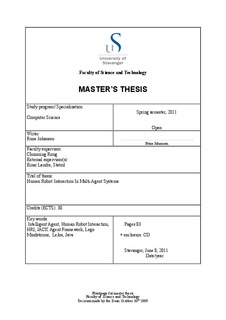| dc.contributor.author | Johansen, Rune | |
| dc.date.accessioned | 2011-09-24T10:42:18Z | |
| dc.date.available | 2011-09-24T10:42:18Z | |
| dc.date.issued | 2011 | |
| dc.identifier.uri | http://hdl.handle.net/11250/181733 | |
| dc.description | Master's thesis in Computer Science | en_US |
| dc.description.abstract | The oil and gas industry experience an increased dependency on IT and particular soft-
ware based capabilities to achieve its business objectives. Core business processes such
as exploration, well construction, production optimization and operations are all fueled
by software and information technology. In coming years we will see that software will
ll more and more advanced features, including central control functions in autonomous
and collaborative robots and it is believed that agent technology may be of use in this
scenario.
The practical bene t from goal oriented systems is a simpli cation of the human-machine
interface. A goal oriented system is able to communicate and react to events in its
environment in context of their goals. This is the primary driver for autonomous systems:
Simplifying and securing operation of machines in an unstructured / highly dynamic
environment.
Human Robot Interaction (HRI) is an important area in development of autonomous
robot systems where an operator is present. The design and solution for the HRI will
be crucial to the systems performance and robustness. An operator can be relieved of
stress as well as have his focus directed to important and critical information at any
given time. In this thesis I will look at how intelligent agents can be used to implement
a system for controlling autonomous robots and how this can provide a good solution
for HRI challenges. To achieve this a multi-agent solution controlling Lego Mindstorms
robots has been developed in cooperation with Eirik Nordb .
The solution is based on three Lego robots operating on a line-based grid. One robot
is set to explore the grid, nding objects, and sharing this information (beliefs) with a
second robot which is responsible for collecting and delivering these objects to a robot
in charge of sorting them according to color. This solution enables investigation of
several challenges in relation to intelligent software agents combined with autonomous
robot/machine systems, such as human robot interaction and inter-agent communica-
tion/coordination.
The agent system is developed using the Prometheus methodology for the design and
the JACK Intelligent Agents framework for the implementation. Regular Java is used
combined with the LeJos - Java For Mindstorms framework to implement the robot side
of the system. | en_US |
| dc.language.iso | eng | en_US |
| dc.publisher | University of Stavanger, Norway | en_US |
| dc.relation.ispartofseries | Masteroppgave/UIS-TN-IDE/2011; | |
| dc.subject | informasjonsteknologi | en_US |
| dc.subject | datateknikk | en_US |
| dc.title | Human Robot Interaction in Multi-Agent Systems | en_US |
| dc.type | Master thesis | en_US |
| dc.subject.nsi | VDP::Technology: 500::Information and communication technology: 550::Computer technology: 551 | en_US |
